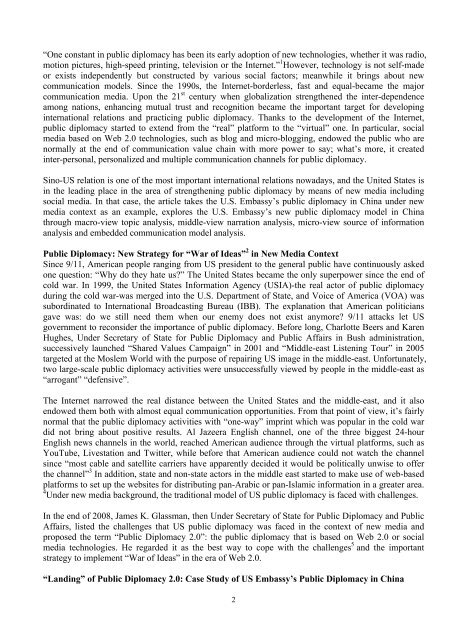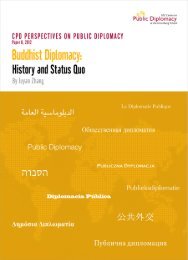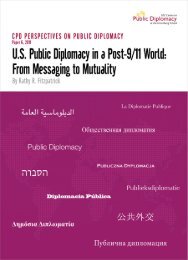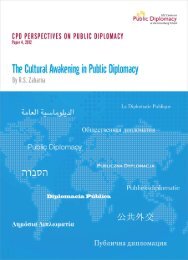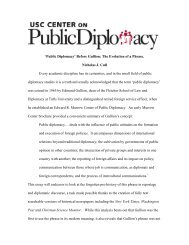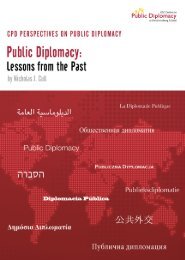Xin Zhong Jiayi Lu- Public Diplomacy Model in the Era of Web 2.0 ...
Xin Zhong Jiayi Lu- Public Diplomacy Model in the Era of Web 2.0 ...
Xin Zhong Jiayi Lu- Public Diplomacy Model in the Era of Web 2.0 ...
Create successful ePaper yourself
Turn your PDF publications into a flip-book with our unique Google optimized e-Paper software.
“One constant <strong>in</strong> public diplomacy has been its early adoption <strong>of</strong> new technologies, whe<strong>the</strong>r it was radio,<br />
motion pictures, high-speed pr<strong>in</strong>t<strong>in</strong>g, television or <strong>the</strong> Internet.” 1 However, technology is not self-made<br />
or exists <strong>in</strong>dependently but constructed by various social factors; meanwhile it br<strong>in</strong>gs about new<br />
communication models. S<strong>in</strong>ce <strong>the</strong> 1990s, <strong>the</strong> Internet-borderless, fast and equal-became <strong>the</strong> major<br />
communication media. Upon <strong>the</strong> 21 st century when globalization streng<strong>the</strong>ned <strong>the</strong> <strong>in</strong>ter-dependence<br />
among nations, enhanc<strong>in</strong>g mutual trust and recognition became <strong>the</strong> important target for develop<strong>in</strong>g<br />
<strong>in</strong>ternational relations and practic<strong>in</strong>g public diplomacy. Thanks to <strong>the</strong> development <strong>of</strong> <strong>the</strong> Internet,<br />
public diplomacy started to extend from <strong>the</strong> “real” platform to <strong>the</strong> “virtual” one. In particular, social<br />
media based on <strong>Web</strong> <strong>2.0</strong> technologies, such as blog and micro-blogg<strong>in</strong>g, endowed <strong>the</strong> public who are<br />
normally at <strong>the</strong> end <strong>of</strong> communication value cha<strong>in</strong> with more power to say; what’s more, it created<br />
<strong>in</strong>ter-personal, personalized and multiple communication channels for public diplomacy.<br />
S<strong>in</strong>o-US relation is one <strong>of</strong> <strong>the</strong> most important <strong>in</strong>ternational relations nowadays, and <strong>the</strong> United States is<br />
<strong>in</strong> <strong>the</strong> lead<strong>in</strong>g place <strong>in</strong> <strong>the</strong> area <strong>of</strong> streng<strong>the</strong>n<strong>in</strong>g public diplomacy by means <strong>of</strong> new media <strong>in</strong>clud<strong>in</strong>g<br />
social media. In that case, <strong>the</strong> article takes <strong>the</strong> U.S. Embassy’s public diplomacy <strong>in</strong> Ch<strong>in</strong>a under new<br />
media context as an example, explores <strong>the</strong> U.S. Embassy’s new public diplomacy model <strong>in</strong> Ch<strong>in</strong>a<br />
through macro-view topic analysis, middle-view narration analysis, micro-view source <strong>of</strong> <strong>in</strong>formation<br />
analysis and embedded communication model analysis.<br />
<strong>Public</strong> <strong>Diplomacy</strong>: New Strategy for “War <strong>of</strong> Ideas” 2 <strong>in</strong> New Media Context<br />
S<strong>in</strong>ce 9/11, American people rang<strong>in</strong>g from US president to <strong>the</strong> general public have cont<strong>in</strong>uously asked<br />
one question: “Why do <strong>the</strong>y hate us?” The United States became <strong>the</strong> only superpower s<strong>in</strong>ce <strong>the</strong> end <strong>of</strong><br />
cold war. In 1999, <strong>the</strong> United States Information Agency (USIA)-<strong>the</strong> real actor <strong>of</strong> public diplomacy<br />
dur<strong>in</strong>g <strong>the</strong> cold war-was merged <strong>in</strong>to <strong>the</strong> U.S. Department <strong>of</strong> State, and Voice <strong>of</strong> America (VOA) was<br />
subord<strong>in</strong>ated to International Broadcast<strong>in</strong>g Bureau (IBB). The explanation that American politicians<br />
gave was: do we still need <strong>the</strong>m when our enemy does not exist anymore? 9/11 attacks let US<br />
government to reconsider <strong>the</strong> importance <strong>of</strong> public diplomacy. Before long, Charlotte Beers and Karen<br />
Hughes, Under Secretary <strong>of</strong> State for <strong>Public</strong> <strong>Diplomacy</strong> and <strong>Public</strong> Affairs <strong>in</strong> Bush adm<strong>in</strong>istration,<br />
successively launched “Shared Values Campaign” <strong>in</strong> 2001 and “Middle-east Listen<strong>in</strong>g Tour” <strong>in</strong> 2005<br />
targeted at <strong>the</strong> Moslem World with <strong>the</strong> purpose <strong>of</strong> repair<strong>in</strong>g US image <strong>in</strong> <strong>the</strong> middle-east. Unfortunately,<br />
two large-scale public diplomacy activities were unsuccessfully viewed by people <strong>in</strong> <strong>the</strong> middle-east as<br />
“arrogant” “defensive”.<br />
The Internet narrowed <strong>the</strong> real distance between <strong>the</strong> United States and <strong>the</strong> middle-east, and it also<br />
endowed <strong>the</strong>m both with almost equal communication opportunities. From that po<strong>in</strong>t <strong>of</strong> view, it’s fairly<br />
normal that <strong>the</strong> public diplomacy activities with “one-way” impr<strong>in</strong>t which was popular <strong>in</strong> <strong>the</strong> cold war<br />
did not br<strong>in</strong>g about positive results. Al Jazeera English channel, one <strong>of</strong> <strong>the</strong> three biggest 24-hour<br />
English news channels <strong>in</strong> <strong>the</strong> world, reached American audience through <strong>the</strong> virtual platforms, such as<br />
YouTube, Livestation and Twitter, while before that American audience could not watch <strong>the</strong> channel<br />
s<strong>in</strong>ce “most cable and satellite carriers have apparently decided it would be politically unwise to <strong>of</strong>fer<br />
<strong>the</strong> channel” 3 In addition, state and non-state actors <strong>in</strong> <strong>the</strong> middle east started to make use <strong>of</strong> web-based<br />
platforms to set up <strong>the</strong> websites for distribut<strong>in</strong>g pan-Arabic or pan-Islamic <strong>in</strong>formation <strong>in</strong> a greater area.<br />
4 Under new media background, <strong>the</strong> traditional model <strong>of</strong> US public diplomacy is faced with challenges.<br />
In <strong>the</strong> end <strong>of</strong> 2008, James K. Glassman, <strong>the</strong>n Under Secretary <strong>of</strong> State for <strong>Public</strong> <strong>Diplomacy</strong> and <strong>Public</strong><br />
Affairs, listed <strong>the</strong> challenges that US public diplomacy was faced <strong>in</strong> <strong>the</strong> context <strong>of</strong> new media and<br />
proposed <strong>the</strong> term “<strong>Public</strong> <strong>Diplomacy</strong> <strong>2.0</strong>”: <strong>the</strong> public diplomacy that is based on <strong>Web</strong> <strong>2.0</strong> or social<br />
media technologies. He regarded it as <strong>the</strong> best way to cope with <strong>the</strong> challenges 5 and <strong>the</strong> important<br />
strategy to implement “War <strong>of</strong> Ideas” <strong>in</strong> <strong>the</strong> era <strong>of</strong> <strong>Web</strong> <strong>2.0</strong>.<br />
“Land<strong>in</strong>g” <strong>of</strong> <strong>Public</strong> <strong>Diplomacy</strong> <strong>2.0</strong>: Case Study <strong>of</strong> US Embassy’s <strong>Public</strong> <strong>Diplomacy</strong> <strong>in</strong> Ch<strong>in</strong>a<br />
2


